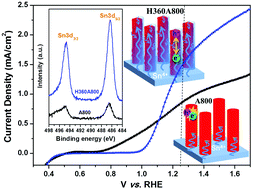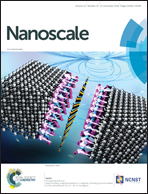Highly self-diffused Sn doping in α-Fe2O3 nanorod photoanodes initiated from β-FeOOH nanorod/FTO by hydrogen treatment for solar water oxidation†
Abstract
In this study, we present an advanced strategy of low-temperature hydrogen annealing combined with high- temperature quenching in air for activating α-Fe2O3 nanorod photoanodes to boost the photoelectrochemical performance. We report that various low-temperature annealing conditions (340, 360, 380, and 400 °C) under hydrogen gas flow convert β-FeOOH into magnetite (Fe3O4) as well as introduce Sn4+ diffusion from FTO substrates to its surface. Furthermore, high-temperature quenching (800 °C) resulted in the phase change of magnetite (Fe3O4) into hematite (α-Fe2O3) and self Sn4+ doping into the hematite lattice. Thus, the hydrogen-assisted thermally activated hematite photoanode achieved a photocurrent density of 1.35 mA cm−2 at 1.23 V vs. RHE and 1.91 mA cm−2 at 1.4 V vs. RHE, which is 70% and 80% higher than that of directly quenched hematite at 800 °C. These combined two step strategies provide new insight into high Sn-self doping for α-Fe2O3 photoanodes and allow for further development of more efficient solar water oxidation systems.



 Please wait while we load your content...
Please wait while we load your content...